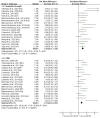Effects of blood flow restriction training on physical fitness among athletes: a systematic review and meta-analysis
- PMID: 39025894
- PMCID: PMC11258269
- DOI: 10.1038/s41598-024-67181-9
Effects of blood flow restriction training on physical fitness among athletes: a systematic review and meta-analysis
Abstract
Blood flow restriction training (BFRT) is an effective, scientific and safe training method, but its effect on the overall quality of athletes remains unclear. The aim of this systematic review with meta-analysis was to clarify the effects of BFRT on the physical fitness among athletes. Based on the PRISMA guidelines, searches were performed in PubMed, Web of Science, SPORTDiscus, and SCOUPS, the Cochrane bias risk assessment tool was used to assess methodological quality, and RevMan 5.4 and STATA 15.0 software were used to analyze the data. A meta-analysis of 28 studies with a total sample size of 542 athletes aged 14-26 years and assessed as low risk for quality was performed. Our results revealed that the BFRT intervention had small to large improvements in the athletes' strength (ES = 0.74-1.03), power (ES = 0.46), speed (ES = 0.54), endurance (ES = 1.39-1.40), body composition (ES = 0.28-1.23), while there was no significant effect on body mass (p > 0.05). Subgroup analyses revealed that moderator variables (training duration, frequency, load, cuff pressure, and pressurization time) also had varying degrees of effect on athletes' physical fitness parameters. In conclusion, BFRT had a positive effect on the physical fitness parameters of the athletes, with significantly improved strength, power, speed, endurance and body composition, but not body mass parameters. When the training frequency ≥ 3 times/week, cuff pressure ≥ 160 mmHg, and pressurization time ≥ 10 min, the BFRT group was more favorable for the improvement of physical fitness parameters.
© 2024. The Author(s).
Conflict of interest statement
The authors declare no competing interests.
Figures







References
-
- Garber CE, et al. American College of Sports Medicine position stand. Quantity and quality of exercise for developing and maintaining cardiorespiratory, musculoskeletal, and neuromotor fitness in apparently healthy adults: Guidance for prescribing exercise. Med. Sci. Sports Exerc. 2011;43:1334–1359. doi: 10.1249/MSS.0b013e318213fefb. - DOI - PubMed
Publication types
MeSH terms
LinkOut - more resources
Full Text Sources
Medical

